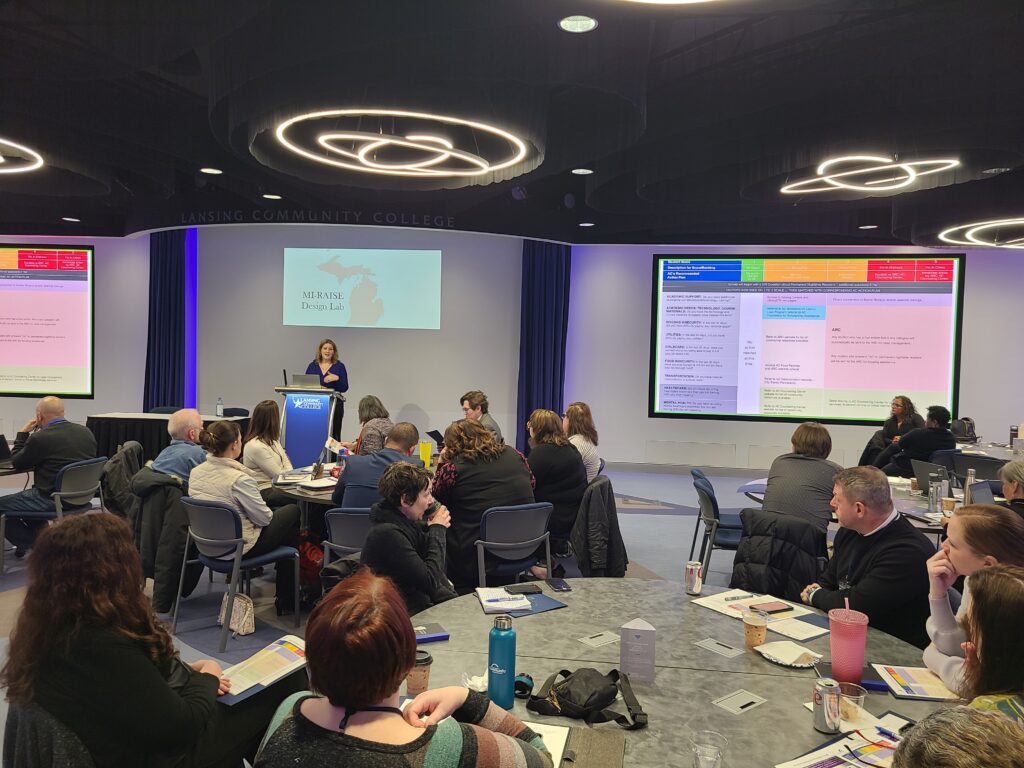Talking about diversity, equity and inclusion is one thing. Measuring progress is another. But it takes real commitment to use that data to create meaningful, lasting advances toward an inclusive culture – instead of making a statement, “checking the box,” and moving on to the next thing.
Kenneth James, chief diversity officer for Muskegon Community College, compares the two approaches to Old Faithful vs. Niagara Falls.
James, keynote speaker at TalentFirst’s recent event, Cultivating an Inclusive Team Culture, invited attendees to picture the crowds of tourists gathered around the famous geyser at Yellowstone National Park in Wyoming.
“They all gather around Old Faithful. The ground rumbles and it erupts. It’s exciting. And then when it’s over, they go back to doing what they were doing,” James said. “But I also want you to picture Niagara Falls in your mind. This waterfall that steadily cascades down. And it never ceases.
“My approach to doing DEI and belonging work is it has to be a Niagara Falls approach. We’re going to move forward and it’s going to continue – as opposed to an Old Faithful approach, where something happened, we’re giving it attention, and then we’re going to check the box and think that we’re done.”
That ongoing commitment is critical to our strategies to make West Michigan a leading region for talent – a point emphasized by Kevin Stotts, TalentFirst president, in his welcoming remarks to attendees.
“We have people we are leaving behind in terms of economic opportunity and success,” Stotts said, challenging the attendees to ask themselves, “How great of a community we can we be?”
Simple Math, Practical Advice
James broke down his presentation, ““Bridging the gap: From assessment to inclusion,” to three main points, each with three takeaways.
- Pre-assessment: Organizations must understand why they are engaged in efforts to promote inclusion. They need a snapshot of the current culture. And they need to recognize how employees and recruits view the organization.
“It’s not how you see you. It’s how others see you. And that’s why the data is very important,” he said. “You can think one thing – and let’s be very honest, depending on the title that we carry, certain things might not make it to your office. People might not be happy working in your organization, but you would never know it because they’re always smiling when you walk through the office.”
- During the assessment: It’s important to recognize the organization’s capacity and resources to sustain a pace toward achievable goals. Once you have the data, don’t get sidetracked by semantics like terminology. And once again, be as persistent as Niagara Falls.
“2020 was a year where we had a lot of things to contend with,” James said. “We had Ahmaud Arbery, Breonna Taylor, and George Floyd, to name a few. And I had businesses that approached me as a practitioner of DEI in 2020 and say, ‘Ken, can you come facilitate a conversation on race? Or can you talk about race relations? And then we want to check the box and think that we’ve done it.’ And I would tell those businesses that I’m hesitant to do this because I approach DEI belonging as a Niagara Falls approach, not an Old Faithful approach.”
- Post-assessment: Never lose sight of the destination, because you can do more harm if you abandon initiatives. Leverage allies to keep the work going. And drive a shift in mindset, to understand eliminating barriers is not handholding – it helps obtain the workforce you need.
“Recruitment without retention is ineffective,” James said, noting he often is asked about return on investment. And the evidence is clear when employees need to be constantly replaced.
“There is research that tells us for a salary position, it takes two and a half times the salary to fill that role,” he said. “If you stop the revolving door on that cycle because of a positive culture, that is the first thing that you can do to see a positive impact in your bottom line.”

Panel Discussion: A Diversity of Perspectives
The session concluded with a panel discussion that brought diverse perspectives to the topic of inclusion. In addition to James, the panel included Marlene Kowalski-Braun, associate vice president for the Division of Inclusion and Equity at Grand Valley State University, Valissa Armstead, NDCCDP, senior director of Diversity, Equity & Inclusion at Corewell Health, Bradford Mathis, vice president of Community Development & Inclusion for Rockford Construction, and Kolene R. Miller, PHR Miller, director of DEI and Talent Acquisition Strategies for Global Perrigo.
Panelists were asked to address one of the key findings of TalentFirst’s most recent Diversity & Inclusion Benchmark Survey (full aggregate results to be released soon), which showed 50% of respondents indicated organization leaders accept managing D&I as a responsibility. Kowalski-Braun asked the panelists to share examples of how their organization ensures that people leaders take ownership of this work.
Some takeaways:
Armstead: “It’s important to understand the ‘why’ and get to the hearts and minds of individuals in order to, one, not only ensure that we can do the work, but to also ensure that the work is sustainable. We also ensure that the message of doing D&I work comes from the top.”
Mathis: “Our core value around diversity is ‘Building strength through diversity.’ And that’s recognizing both physical diversity as well as diversity of thoughts and ideas in an environment of safety, with a sense of belonging and having fun.”
James: “I love this phrase, ‘actions speak louder than words.’ And an example is being visible around inclusion-related events. … We also sit together as a cabinet and make sure everything that we implement has an inclusive lens. So not only do we talk the talk, we walk the walk.”
Miller: “We recently updated our values, and we added Curiosity. … There is not a leader in our business that can say, ‘You know, DEI doesn’t really fall in my scope of responsibility.’ And so, we’ve really tried to embed that, but at the same time we try to create a space for people who may not be as comfortable, who may they fear saying and doing the wrong thing.”
Moving Forward
The event included a preview of the aggregate findings from the Benchmark Survey. Some key points indicated progress along with room to improve. For example:
One in 3 new hires since 2019 were Black, Indigenous, People of Color. Although the survey found increases in BIPOC representation at most leadership roles, it also found a decrease in those promotions among internal candidates.
In addition to the finding that half of the participants see leaders accepting D&I as a responsibility:
- 1 in 2 stated their D&I plan is embedded in their organizational culture
- 45% indicated their D&I plan included measurable goals
- 44% provide D&I training specific to managers
Stay tuned for more aggregate date from the Benchmark Survey as we take the Niagara Falls approach to developing strategies to make West Michigan known as a region where everyone is welcome, and everyone has the opportunity to thrive.


